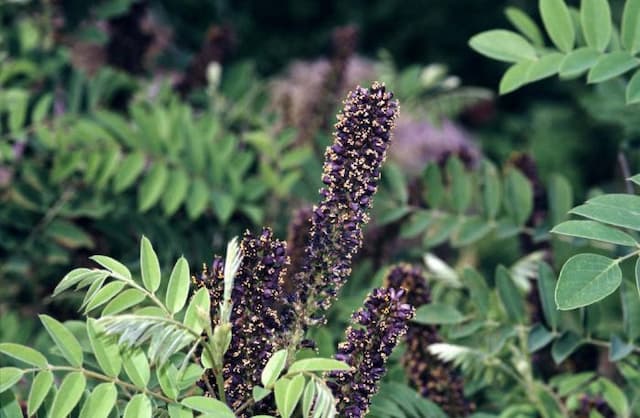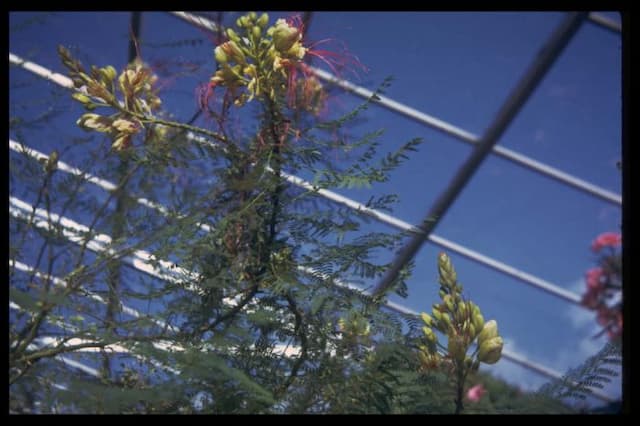White Kakabeak Clianthus puniceus 'Albus'

ABOUT
Clianthus puniceus 'Albus', commonly known as white kaka beak, is an eye-catching plant primarily recognized for its distinctive white flowers, which closely resemble the beak of the Kaka bird. The flowers are pendulous, coming together in clusters that dangle elegantly from the branches. Each flower in the cluster showcases flaring petals, providing a somewhat flamboyant display. The foliage of the white kaka beak consists of dark green, pinnate leaves that are compound in structure, meaning they are made up of multiple leaflets along a central stem. These leaflets are delicate and oval-shaped with pointed tips, contributing to the plant's overall feathery texture. While the white blooms are the highlight, the contrast of these against the green leaves adds to its ornamental appeal. The flowering season brings a profusion of these creamy-white blossoms which not only add visual interest but may also attract pollinators such as bees and birds. Overall, the white kaka beak's distinct flower shape and the bright contrast between its blossoms and foliage make it an attractive addition to any garden where it can be cultivated successfully.
About this plant
 Names
NamesFamily
Fabaceae
Synonyms
White Kakabeak, White Lobster Claw, White Parrot's Beak, White Kowhai Ngutukākā
Common names
Clianthus puniceus 'Albus'
 Toxicity
ToxicityTo humans
The plant commonly known as Lobster Claw is not widely known for its toxicity to humans. However, as with many ornamental plants, it is generally advisable to avoid ingesting parts of it, as they may cause stomach upset or allergic reactions in some individuals. There is limited information available on the specific symptoms of poisoning from this plant because it is not commonly recognized as a toxic plant to humans.
To pets
The Lobster Claw plant is not specifically listed as toxic to pets such as dogs and cats. However, it's still a good practice to prevent pets from eating ornamental plants as they could potentially cause gastrointestinal upset, vomiting, or diarrhea due to the plant's foreign nature to their digestive system. It is recommended to monitor your pets and keep ornamental plants out of their reach to avoid any potential issues. If you suspect your pet has ingested the plant and is showing adverse symptoms, contacting a veterinarian is the best course of action.
 Characteristics
CharacteristicsLife cycle
Perennials
Foliage type
Evergreen
Color of leaves
Green
Flower color
White
Height
6-10 feet (1.8-3 meters)
Spread
6 feet (1.8 meters)
Plant type
Shrub
Hardiness zones
9
Native area
New Zealand
Benefits
 General Benefits
General Benefits- Aesthetic Appeal: The plant produces striking white flowers that can enhance the visual interest and beauty of a garden or landscape.
- Attracts Wildlife: It is known to attract birds, particularly nectar-feeding species, which can contribute to a vibrant ecosystem in the garden.
- Drought Tolerance: Once established, the plant has a degree of drought resistance, making it suitable for regions with water scarcity or for low-water gardens.
- Easy to Propagate: It can be easily propagated from seed or cuttings, allowing gardeners to share and spread the plant.
- Fast Growing: The plant has a relatively rapid growth rate, which allows for quick establishment and filling in of garden spaces.
- Cultural Significance: In New Zealand, where the plant is known as Kakabeak, it holds importance in Maori culture which adds an element of heritage and story to a garden.
 Medical Properties
Medical PropertiesThis plant is not used for medical purposes.
 Air-purifying Qualities
Air-purifying QualitiesThis plant is not specifically known for air purifying qualities.
 Other Uses
Other Uses- Crafting Natural Dyes: The Lobster Claw can be used to derive natural dyes for textiles and other materials due to the pigmentation in its flowers.
- Education and Research: Botanical gardens may use Lobster Claw in educational programs to showcase unique flora and discuss plant adaptation and pollination mechanisms.
- Culinary Garnish: Though not widely eaten, the unique flowers of the Lobster Claw can sometimes serve as an exotic garnish in gourmet cuisine.
- Photography: The distinctive appearance of the Lobster Claw makes it a sought-after subject for botanical photographers and artists.
- Horticultural Therapy: Lobster Claw may be included in therapeutic garden settings for its striking visual appeal, which can contribute to mental well-being.
- Ecosystem Support: It can provide habitats and resources for a range of native insects, potentially contributing to local biodiversity.
- Soil Erosion Control: Lobster Claw's root systems can help stabilize the soil in gardens and prevent erosion.
- Potential Biomonitoring: The plant could potentially be used to monitor environmental health, particularly in assessing soil quality or pollutant absorption.
- Floral Arrangements: Lobster Claw flowers can be used in floral arrangements and bouquets due to their unique shape and striking color.
- Symbolic Planting: In some communities, planting Lobster Claw may carry symbolic meaning, such as commemorating a special event or representing a dedication to conservation.
Interesting Facts
 Feng Shui
Feng ShuiThe Lobster Claw is not used in Feng Shui practice.
 Zodiac Sign Compitability
Zodiac Sign CompitabilityThe Lobster Claw is not used in astrology practice.
 Plant Symbolism
Plant Symbolism- Rarity: The Clianthus puniceus 'Albus', commonly known as White Kakabeak, is a rare variety compared to its red-flowered counterpart, symbolizing uniqueness and exclusivity.
- Endurance: Surviving in tough environmental conditions implies the quality of resilience and standing strong through challenges.
- Attention-grabbing: The distinct white flowers of the White Kakabeak can represent the idea of being noticed or gaining attention in a sea of sameness.
- Conservation: Since Clianthus puniceus species are threatened in the wild, this plant symbolizes the need for conservation and the importance of environmental protection.
 Water
WaterThe Lobster Claw should be watered regularly during its growing season, ensuring that the soil is kept moist but not waterlogged. Depending on the temperature and humidity, water about once a week with approximately 1 to 2 gallons of water, but always check the top inch of the soil for dryness before watering. In the winter, reduce watering to every other week, providing just enough water to prevent the soil from drying out completely, roughly 1 gallon each time.
 Light
LightThe Lobster Claw prefers full sun to partial shade, thriving in a location that receives several hours of direct sunlight each day. However, in very hot climates, it benefits from some afternoon shade to protect it from the intense heat.
 Temperature
TemperatureThe Lobster Claw flourishes in temperatures ranging from 50 to 75°F, but it can survive in minimum temperatures down to 40°F. The plant does best when not subjected to temperatures below freezing. It prefers a mild climate without extremes of heat or cold.
 Pruning
PruningPrune the Lobster Claw to maintain its shape and encourage bushier growth. Pruning is best done in the late winter or early spring before new growth begins. Cut back any leggy stems and remove dead or damaged growth. Pruning once a year is typically sufficient for maintaining a healthy plant.
 Cleaning
CleaningAs needed
 Soil
SoilThe Lobster Claw, found under the botanical name Clianthus puniceus 'Albus', thrives in well-draining soil with a slightly acidic to neutral pH of 6.0 to 7.5. A soil mix consisting of loam, peat, and sharp sand or perlite in equal parts can provide the necessary drainage and aeration. Make sure to amend the soil with organic matter to increase fertility.
 Repotting
RepottingLobster Claw plants should be repotted every 2 to 3 years. Younger plants grow rapidly and may need repotting annually. Choose a pot just slightly larger than the previous one to avoid waterlogging which can lead to root rot.
 Humidity & Misting
Humidity & MistingLobster Claw prefers moderate to high humidity levels, around 50-70%. Providing a pebble tray with water beneath the plant or misting regularly can help maintain the desired humidity without affecting the watering regime.
 Suitable locations
Suitable locationsIndoor
Place Lobster Claw in bright, indirect light.
Outdoor
Plant in dappled shade, shield from harsh sun.
Hardiness zone
9-11 USDA
 Life cycle
Life cycleThe life of Clianthus puniceus 'Albus', commonly known as White Kakabeak, begins with seed germination, where seeds require a warm temperature and a pre-treatment such as scarification to break dormancy. After germination, seedlings establish themselves and enter a vegetative growth phase characterized by the development of foliage and a bushy structure. As the plant matures, it enters the flowering phase, usually in spring or early summer, producing distinctive white flowers that resemble the beak of a kākā bird. Following pollination, these flowers develop into pods containing seeds, completing the reproductive phase. The plant may then enter a period of dormancy, especially in areas with cooler winters, where it conserves energy before the next growing season. With the arrival of favorable conditions, the White Kakabeak resumes growth, and the cycle continues, typically living several years before senescence occurs and the plant dies.
 Propogation
PropogationPropogation time
Spring-Early Summer
The Clianthus puniceus 'Albus', commonly known as the white kakabeak, is a plant that can be propagated through semi-hardwood cuttings. This method is popular for its effectiveness and relative simplicity. The best time to take cuttings for propagation is during late summer or early autumn. To propagate, select healthy, disease-free stems and cut a segment around 4 to 6 inches (approximately 10 to 15 centimeters) long, ensuring there are at least a couple of leaf nodes present. The lower leaves should be removed and the base of the cutting can be dipped in rooting hormone to encourage root development. Then, the cuttings should be placed in a well-drained potting mix and kept under conditions with high humidity and indirect sunlight. Roots typically develop within a few weeks, after which the new plants can be gradually acclimatized to outdoor conditions before planting out.








